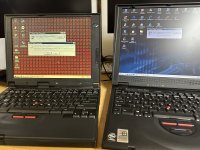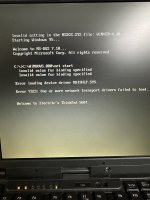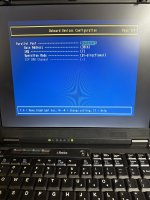Upcoming Events:
- VCF South West - June 14 - 16, Davidson-Gundy Alumni Center at University of Texas at Dallas
- VCF West - Aug 2 - 3, Computer History Museum, Mountain View, CA
- VCF Midwest - Sept 7 - 8 2024, Schaumburg, IL
- VCF SoCal - Mid February 2025, Location TBD, Southern CA
- VCF East - April 2025, Infoage Museum, Wall NJ
-
Please review our updated Terms and Rules here
- Forums
- Companies
- IBM Computers, PCs, Clones and Descendants
- Pentium (First generation) Class Machines
You are using an out of date browser. It may not display this or other websites correctly.
You should upgrade or use an alternative browser.
You should upgrade or use an alternative browser.
Can’t get direct cable connection to work
- Thread starter 3lectr1c
- Start date
daver2
10k Member
Long shot here, but have you checked the BIOS settings to see if there are any related to the parallel port?
Dave
Dave
twolazy
Veteran Member
What cable are you using? And I would try Laplink over using the built in DCC,
Cable is a generic db25 cable. Could be the issue? I bought it to use as a scsi cable so it could be missing conductors, but it is a generic with no markings either way. It works for scsi. Don’t know what laplink is I’m afraid.
seaken
Veteran Member
I've owned Laplink since about 1988. It is a software program by Traveling Software to help transfer files between two computers easy enough for a non-techie. The idea was for office folks who traveled with their laptop to be able to connect the laptop to their work station desktop at the office and transfer files back and forth to synchronize their data. Laplink came with two cables, one was for use with the serial ports and one was for use with the parallel ports. Eventually cables that were similarly designed became known a "Laplink Cables". The serial cables are basically a null-modem cable where the transmit and receive signals were physically switched so that a direct communication could easily be setup between the two computers.
You need to use a different cable. A straight thru cable may not work for what you are trying to do. The parallel cable can also be wired for direct communication similar to a null-modem. Sometimes the software can be adjusted to work with a straight thru cable but the software has to support it. Check your cable. Or try the serial ports and a null-modem cable (aka "Laplink cable").
Seaken
You need to use a different cable. A straight thru cable may not work for what you are trying to do. The parallel cable can also be wired for direct communication similar to a null-modem. Sometimes the software can be adjusted to work with a straight thru cable but the software has to support it. Check your cable. Or try the serial ports and a null-modem cable (aka "Laplink cable").
Seaken
I've used DCC over a serial cable in the past. Installed Office 95 through it, not recommended. Slow as molasses, but worked reliably...
On a different note: Does anyone have a good description of the DCC serial wire protocol? Since it is part of Windows, it would be a decent way to connect to modern machines if there was a decent client on the other end. Especially since it supports TCP/IP as well.
On a different note: Does anyone have a good description of the DCC serial wire protocol? Since it is part of Windows, it would be a decent way to connect to modern machines if there was a decent client on the other end. Especially since it supports TCP/IP as well.
At the software level both serial and parallel DCC are just PPP. There's an exchange at the beginning where one side says CLIENT and the other says CLIENTSERVER (don't remember exactly which order) but then they just switch to PPP, so it's something you can handle with a chat script. There are Linux HOWTOs out there walking through how to set it up for serial.I've used DCC over a serial cable in the past. Installed Office 95 through it, not recommended. Slow as molasses, but worked reliably...
On a different note: Does anyone have a good description of the DCC serial wire protocol? Since it is part of Windows, it would be a decent way to connect to modern machines if there was a decent client on the other end. Especially since it supports TCP/IP as well.
At the hardware level, the serial one is just RS-232 of course, and the parallel one is implemented in Paralink.vxd as a custom protocol where various nibble values are sent to the other side to transition through states of the protocol, and there are checksums implemented. I have a partially working compatible implementation, but still need to flesh out the state machine and such to improve its handling of deadlocks and timeouts and such. It is much faster than 115K serial, however; if I remember right, about 20 KB/s transfers. This is "nibble mode" and works with a LapLink cable, but is very CPU-intensive. The server end has to pace itself with intentional delays to avoid overwhelming the other (vintage) machine. There is also an MTU-like setting to break up transmissions over the parallel cable and sometimes shrinking it actually improves the transfer rate. Digi-Key still sells LapLink cables, by the way.
Paralink.vxd was outsourced to Parallel Technologies (PTI) which I remember from early 2000s as they offered as freeware a replacement paralink.vxd and an enhanced diagnostic utility. They also sold an intelligent parallel cable (but I've never been able to find one) that buffered both sides and spoke ECP or EPP to each end of the connection and relayed it to the other machine, so as to be faster and not CPU intensive.
Ruud
Veteran Member
And what is DCC? Google didn't help me here. TIA!
twolazy
Veteran Member
Direct Cable Connection
Anton156
Member
I remember having problems with DCC on some computers. Sometimes it would work perfectly, sometimes it would just disconnect randomly, on 2 identical computers. Never understood what was wrong, maybe some extra stuff to config in Windows.
Anton156
Member
Yes, Laplink 5 for DOS or Laplink 6 for Win 3.1. (LL 7 for Win95)
You can build cable easy, check on internet laplink serial cable pinout and create one.
You can build cable easy, check on internet laplink serial cable pinout and create one.
twolazy
Veteran Member

SL666 Parallèle Laplink Style, 3M Type Câble | eBay
Find many great new & used options and get the best deals for SL666 Parallèle Laplink Style, 3M Type Câble at the best online prices at eBay! Free shipping for many products!
www.ebay.com
And yes, there are multiple programs that will work in DOS or Win 3.1, including Laplink. For DOS I use FastLynx.
That's pretty darn cheap. Might have to pick one of those up soon if they'll finally solve my seemingly endless file transfer issues between my PCs. One issue I do see is this - my duo of WinBook laptops both have dead floppy drives so I can't get files on or off of them. The keyboard connectors are also fragile enough that I really don't want to risk it and take the hard drives out to get stuff on to them. Is there anything built into Windows 3.1 that could help to get DCC working?



